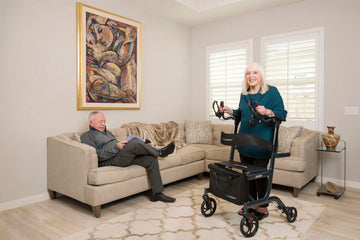M-F 9:30am - 7pm EST
The Ultimate Guide to Mobility Scooters

A mobility scooter is a battery-powered device that helps people who have trouble walking or standing for long periods. It lets you move around easily, both indoors and outdoors, so you can keep doing the things you enjoy, like shopping, going to the park, or visiting family and friends.
Many people find that using a mobility scooter helps them maintain their independence. Instead of relying on others for rides or assistance, you can get where you want to go on your own schedule. This sense of freedom can boost your confidence and overall well-being. Mobility scooters also make it easier to stay connected with others, supporting both your happiness and health.
Millions of people, especially older adults, use mobility scooters every day. If you have trouble walking long distances, feel tired easily, or are concerned about falling, a mobility scooter might be a great option for you! This guide is here to help you make an informed decision about choosing the right mobility scooter for your needs.
Benefits of Mobility Scooters
Mobility scooters offer freedom of movement in both indoor and outdoor environments. These mobility aids provide many benefits, including:
- More Independence: You can do daily tasks and go places without needing help from others. Many public places and transportation systems are equipped to accommodate mobility scooters, making it easier to travel and access different locations.
- More Comfort: Scooters reduce the strain on your body, so you can do more without getting tired.
- Better Social Life: With a scooter, you can join family events, visit friends, or go to community activities.
- Improved Health: Studies show that people who use scooters spend more time outside, which is good for your heart and joints.
- Safe and Easy to Use: Scooters are designed to be stable and comfortable. They have features like comfortable seats and easy controls.
- Affordable and Eco-Friendly: Scooters cost less than cars to buy and maintain. They run on batteries, not gasoline, so they are better for the environment.
Types of Mobility Scooters for Seniors
As with any mobility device, there are a variety of options available to meet specific needs. Some mobility scooters are designed for travel, with a focus on being lightweight and compact enough for easy transportation and storage. Heavy-duty multi-terrain designs are best for outdoor use.
The main difference between types of scooters is the number of wheels. Three-wheel scooters tend to have tighter turn radius, making them easier to navigate indoors and in tight spaces. Four-wheel scooters offer more stability and are better suited for outdoor use. Here’s a quick overview of how they compare:
3-Wheel Scooters
- Ideal for indoor use and tight spaces thanks to a tighter turning radius. Easier to navigate in crowded areas.
- Tend to be lightweight and easier to transport.
- Less stable on uneven terrain.
- Often has a lower weight capacity.
4-Wheel Scooters
- Better stability for outdoor use and uneven surfaces.
- Supports higher weight capacities.
- Usually has larger wheels and stronger frames.
- Heavier and less portable.
- Larger turning radius can be difficult for indoor use and navigating crowded outdoor spaces.
Portable Scooters vs. Full-Size Scooters
There’s another major difference to consider when evaluating mobility scooters: portable versus full-size models. Portable mobility scooters are lightweight, often foldable or easy to disassemble, and designed for effortless transport. They’re ideal for travel and everyday use without a vehicle lift. Full-size scooters are built for outdoor adventures with greater weight capacity and battery life, but their size makes them less suitable for indoor or tight spaces.
Now that you have a general overview of the differences between 3-wheel and 4-wheel scooters, keep reading to learn what to consider when selecting a scooter.
Choosing a Mobility Scooter
Determining where the scooter will be used is one of the first steps to finding the right scooter for your needs.
Do you want to use your scooter for outdoor activities such as exploring local parks and attending baseball games? Do you spend a lot of time participating in indoor activities that require a lot of standing or walking, such as attending quilt shows or shopping? Do you need your scooter to be able to navigate tight turns or hallways in your home, or will you mostly use it outside of your house?
You’ll also want to think about personal mobility needs such as the necessary weight capacity and comfort features. You need to have enough upper body strength to control the scooter and stay balanced. If you plan to use your scooter for extended periods, you’ll want to ensure that the seat is comfortable, and you have a way to easily reach your personal items. Many scooters include carrying baskets or storage pouches for this purpose; these types of scooter accessories can enhance your experience.
Consider your physical capabilities and limitations. Are you looking for an ultralight scooter that you can easily fold and reassemble on the go? Do you need a more heavy-duty model that has greater stability on uneven surfaces? How will you transport the scooter? Does it need to fit in the back seat or trunk of your car or SUV?
Travel range for mobility scooters can vary greatly depending on factors such as battery capacity, terrain, and the user’s weight. What is the maximum speed and operating range needed for your lifestyle? How often will you need to recharge your mobility scooter?
Quick Questions for Choosing a Mobility Scooter
- Where will you use it? Indoors, outdoors, or both?
- How much weight does it need to hold? Make sure the scooter can support your weight.
- How far do you need to go? Check the battery life and how far the scooter can travel on one charge.
- Is it comfortable? Look for a padded seat, armrests, and enough legroom.
- Can you transport it? If you plan to take the scooter in a car, choose a lightweight or foldable model.
- What safety features does it have? Look for key features like anti-tip wheels, lights, and good brakes.
Mobility Scooter Safety Features
Mobility scooters offer a variety of safety features. Anti-tip wheels prevent scooters from tipping over on inclined and uneven surfaces. Lights ensure visibility in low-light conditions. An emergency braking system allows you to stop immediately when needed. Adjustable speed settings allow you to control speed based on the environment. Seatbelts and armrests offer enhanced stability and comfort when riding your scooter.
Accessories to Enhance Your Mobility Scooter
To personalize and optimize your scooter experience, consider these popular accessories:
- Storage Baskets and Bags: For carrying groceries or personal items.
- Cane or Walker Holders: Conveniently store mobility aids.
- Weather Covers: Protect your scooter from rain and dust.
- Seat Cushions: Enhance comfort for extended use.
- Phone Holders and USB Ports: Stay connected while on the go.
Mobility Scooters FAQ
What are mobility scooters used for?
They help people with mobility challenges move around more easily, both indoors and outdoors.
Are mobility scooters best for indoor or outdoor use?
It depends on the scooter. Some are best for indoors and in tight spaces, while others are better for outdoor use on rough ground.
What maintenance is needed for mobility scooters?
Scooters need regular cleaning and basic care. Check the tires, keep the scooter dry, and get it checked by a professional once a year.
What does a mobility scooter cost?
Most adult mobility scooters cost between $600 and $3,000.
How do I transport my mobility scooter?
Lightweight, foldable scooters can be lifted into most cars. For heavier scooters, use a ramp or lift, or consider a vehicle carrier. Most buses and trains can accommodate scooters. Just let the driver know you’re bringing one onboard. Always secure your scooter so it doesn’t move while traveling. If flying, check with your airline for rules about batteries and packing.
Do I need insurance for a mobility scooter?
Insurance isn’t legally required for most mobility scooters, but it is strongly recommended. There are two main types of coverage:
Liability insurance protects you if you accidentally injure someone or damage property while using your scooter.
Property insurance covers your scooter in case of theft, accidental damage, or other losses.
Some policies also offer extras like breakdown assistance or personal accident cover. While not mandatory, having insurance can give you peace of mind and protect you from unexpected costs.
Find Your Perfect Mobility Scooter
Choosing the right mobility scooter can make a big difference in your daily life. Just ask the users who have already experienced the benefits! One So Lite® Scooter owner shared, “This scooter is lightweight and easy to use. I can get it in and out of the car by myself. I purchased this scooter because it folds rather than having to take apart/put together as required by other scooter brands. I am enjoying the freedom it gives me to be able to travel around.”
Finding a scooter that fits your lifestyle and mobility needs is important. Whether you want something easy to transport or a model that handles different terrains, there’s a perfect scooter out there for you.
Journey Health & Lifestyle product specialists are here to answer your questions and help you find the right mobility solution for your unique needs. Call today to take the next step toward independence!











